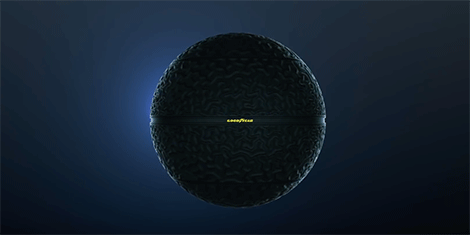
Goodyear Eagle 360 concept tyres are helping visualise the transport of the future
While we cover much to do with the automotive industry, tyres are typically left out of the story as a third party product with little to do with the car they’ll be mounted on.
Goodyear, with its latest concept for the tyre of the future, has changed all that, adding much more to the design and make up of its grippy rubber – incorporating biomimicry, IoT sensors, 3D printing as well as being spherical and being mounted to the car via magnetic levitation.
The Goodyear Eagle 360 concept highlights ultimate maneuverability, safety and connectivity for the driverless car of the future, where this concept plays a dual role both as a creative platform to push the boundaries of conventional thinking and as testbeds for next-generation technologies.
https://youtube.com/watch?v=oSFYwDDVgac%3Frel%3D0%26controls%3D0%26showinfo%3D0
“By steadily reducing the driver interaction and intervention in self-driving vehicles, tires will play an even more important role as the primary link to the road,” suggests Joseph Zekoski, Goodyear’s senior VP and CTO.
The unique shape of the Goodyear Eagle 360 could contribute to safety and maneuverability to match the demands of autonomous mobility.
The spherical shape of the tire is key to delivering ultimate maneuverability – Active technology allows the tire to move as needed to reduce sliding from potential hazards, such as black ice or sudden obstacles, so it contributes to staying on a safe path.
In addition, the spherical shape of the Goodyear Eagle 360 provides a smooth ride by creating a fluid, lateral movement, while 360 degree turns are possible with this tire, allowing it to tackle anticipated parking constrictions of the future, as less space will be needed for cars fitted with spherical tires to pull into parking spots.

The treads and grooves use patterns found in nature to maintain the best grip and water displacement
The tread mimics the pattern of brain coral, and its multidirectional blocks and grooves help to secure a safe contact patch, while equally Jacques Cousteau is the groove bottom, which has the same elements as a natural sponge, which stiffens when dry yet softens when wet to deliver adequate driving performance and aquaplaning resistance.
This texture also absorbs water on the road and ejects water from the tire footprint through centrifugal force to reduce the risk of aquaplaning, while 3D printing is used for localised manufacture, allowing custom trees for exact regions of use.
Within all this, sensors monitor road conditions, tyre tread and pressure, communicating this information to the car as well as to other vehicles to enhance road safety.






